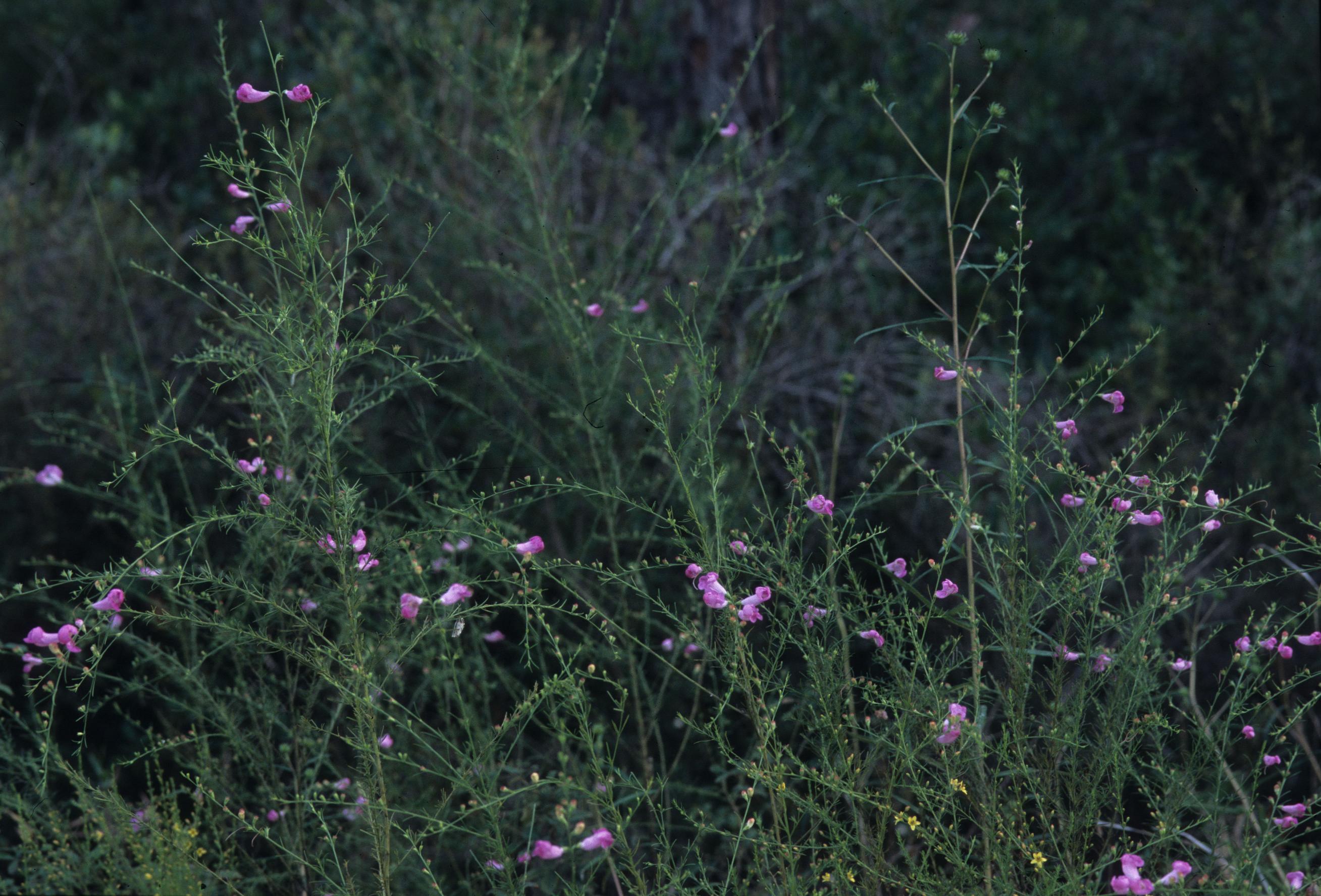Difference between revisions of "Agalinis fasciculata"
(→Pollination) |
(→Description) |
||
| Line 19: | Line 19: | ||
==Description== | ==Description== | ||
<!-- Basic life history facts such as annual/perrenial, monoecious/dioecious, root morphology, seed type, etc. --> | <!-- Basic life history facts such as annual/perrenial, monoecious/dioecious, root morphology, seed type, etc. --> | ||
| − | It is an annual plant and it produces large, pink flowers in late summer (Musselman et al 1979). Numerous small capsules each carrying hundreds of brown honeycombed seeds mature in late autumn (Musselman et a 1979). Agalinis fasciculata is a root hemiparasite. A great variety of herbaceous and woody plants make up its host range. (Musselman et al 1979). | + | Beach False Foxglove (Wunderlin and Hansen 2003). Cluster-leaf Gerardia (Hall 1993). |
| + | |||
| + | Synonym names: A. fasciculata var. peninsularis Pennell; Gerardia fasciculata Elliott; Gerardia fasciculata subsp. peninsularis (Pennell) Pennell (Wunderlin and Hansen 2003). | ||
| + | |||
| + | It is an annual plant and it produces large, pink flowers in late summer (Musselman et al 1979). Numerous small capsules each carrying hundreds of brown honeycombed seeds mature in late autumn (Musselman et a 1979). Agalinis fasciculata is a root hemiparasite. A great variety of herbaceous and woody plants make up its host range. (Musselman et al 1979). Annual (Radford 1964). Plant dark green, 2.5 m tall; stems scabrous on the midveins; corolla deep pink with red spots and yellow lines in the throat, 15-30 mm long; style and stigma exserted (Wunderlin and Hansen 2003). Flowers summer to fall or all year in southern peninsula (Wunderlin and Hansen 2003). | ||
| + | |||
==Distribution== | ==Distribution== | ||
==Ecology== | ==Ecology== | ||
Revision as of 13:51, 29 June 2015
| Agalinis fasciculata | |
|---|---|

| |
| Photo was taken by Gil Nelson | |
| Scientific classification | |
| Kingdom: | Plantae |
| Division: | Magnoliophyta - Flowering plants |
| Class: | Magnoliopsida - Dicotyledons |
| Order: | Scrophulariales |
| Family: | Scrophulariaceae |
| Genus: | Agalinis |
| Species: | A. fasciculata |
| Binomial name | |
| Agalinis fasciculata (Elliott) Raf. | |

| |
| Natural range of Agalinis fasciculata from USDA NRCS Plants Database. | |
Contents
Description
Beach False Foxglove (Wunderlin and Hansen 2003). Cluster-leaf Gerardia (Hall 1993).
Synonym names: A. fasciculata var. peninsularis Pennell; Gerardia fasciculata Elliott; Gerardia fasciculata subsp. peninsularis (Pennell) Pennell (Wunderlin and Hansen 2003).
It is an annual plant and it produces large, pink flowers in late summer (Musselman et al 1979). Numerous small capsules each carrying hundreds of brown honeycombed seeds mature in late autumn (Musselman et a 1979). Agalinis fasciculata is a root hemiparasite. A great variety of herbaceous and woody plants make up its host range. (Musselman et al 1979). Annual (Radford 1964). Plant dark green, 2.5 m tall; stems scabrous on the midveins; corolla deep pink with red spots and yellow lines in the throat, 15-30 mm long; style and stigma exserted (Wunderlin and Hansen 2003). Flowers summer to fall or all year in southern peninsula (Wunderlin and Hansen 2003).
Distribution
Ecology
Habitat
It can be found in frequently burned pine sandhills (Entisols), flatwoods (Spodosols), upland pine communities and shortleaf pine-oak-hickory woodlands (Ultisols), as well as calcareous glades, and margins of ponds, lakes, depressions, marshes, and wet meadows, and on the borders of dunes (Musselman et al 1979; FSU Herbarium). It occurs on a wide range of soil types from deep sands to loamy clay (FSU Herbarium). It requires high light provided by frequently burned areas (Musselman et al. 1979; FSU Herbarium). It can occur on very disturbed soils, such those in railroad and power line rights-of-way, clear-cut areas, disturbed roadsides, dredged up sand, and site-prepped pine forests (Musselman et al 1979; FSU Herbarium). It appears to be somewhat salt tolerant given its proximity to salt marshes (Musselman et al. 1979) and co-existence with Spartina bakari and other brackish and salt water plants (FSU Herbarium).
Phenology
Seed dispersal
Seed bank and germination
Fire ecology
Pollination
Mark Deyrup at Archbold Biological Station observed these Hymenoptera species on Agalinis fasciculata
Colletidae: Hylaeus confluens
Halictidae: Augochlorella gratiosa
Megachilidae: Megachile albitarsis
Use by animals
Diseases and parasites
Conservation and Management
Cultivation and restoration
Photo Gallery
References and notes
Musselman, L. J. and W. F. Mann, Jr (1979). "Agalinis fasciculata (Scrophulariaceae), a native parasitic weed on commercial tree species in the southeastern United States." American Midland Naturalist 101: 459-464.
FSU herbarium http://herbarium.bio.fsu.edu/